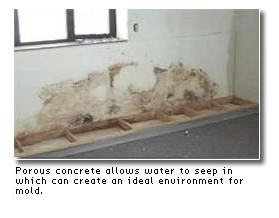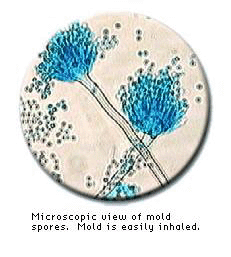|
Mold
Problems
Mold Information  What is mold?
What does mold need to grow?
Mold only needs a few simple things to grow and multiply: - Moisture
- Nutrients
- Suitable place to grow
Of these, controlling excess moisture is the key to preventing
and stopping indoor mold growth.
Should I be concerned about mold in my home? Mold should not be permitted to grow and multiply
indoors. When this happens, health problems can occur and building materials, goods and furnishings may be damaged.
Health Effects
Can mold make
me and my family sick? Mold can affect the health of people who are exposed to it. People are mainly
exposed to mold by breathing spores or other tiny fragments. People can also be exposed through skin contact with mold contaminants
(for example, by touching moldy surfaces) and by swallowing it.
The type and severity of health
effects that mold may produce are usually difficult to predict. The risks can vary greatly from one location to another, over
time, and from person to person.

What symptoms might
I see? Superior Home Inspections The most common health problems caused by indoor mold are allergy symptoms. Although
other and more serious problems can occur, people exposed to mold commonly report problems such as:
-
Nasal and sinus congestion
- Wheeze/breathing difficulties
- Upper respiratory infections (including sinus)
Are
the risks greater for some people? There is wide variability in how different people are affected by indoor mold. However,
the long term presence of indoor mold growth may eventually become unhealthy for anyone. The following types of people may
be affected more severely and sooner than others:
- Individuals with respiratory conditions or sensitivities such as allergies and asthma
- Persons having weakened immune systems (for example, people with HIV infection, chemotherapy patients,
organ transplant recipients)
- Those with special health concerns should consult a medical professional if they feel
their health is affected by indoor mold. Are some molds more hazardous than others?
Some types of mold can produce chemical compounds (called mycotoxins) although they do not always do so. Molds that are able
to produce toxins are common. In some circumstances, the toxins produced by indoor mold may cause health problems. However,
all indoor mold growth is potentially harmful and should be removed promptly, no matter what types of mold is present or whether
it can produce toxins.
Home Investigation How do I tell if I have a mold problem? Investigate,
don't test. The most practical way to find a mold problem is by using your eyes to look for mold growth and by using your
nose to locate the source of a suspicious odor. If you see mold or if there is an earthy or musty smell, you should assume
a mold problem exists. Other clues are signs of excess moisture or the worsening of allergy-like symptoms.
Look for visible mold growth (may appear cottony, velvety, granular, or leathery and have varied colors of white, gray, brown,
black, yellow, green). Mold often appears as discoloration, staining, or fuzzy growth on the surface of building materials
or furnishings.
 Search areas with noticeable mold odors.Superior Home Inspections Search areas with noticeable mold odors.Superior Home Inspections
- Look for signs of excess moisture or water
damage.
- Look for water leaks, standing water, water stains, condensation problems. For example, do you see
any watermarks or discoloration on walls, ceilings, carpet, woodwork or other building materials?
- Search
behind and underneath materials (carpet and pad, wallpaper, vinyl flooring, sink cabinets), furniture, or stored items (especially
things placed near outside walls or on cold floors).
- Sometimes destructive techniques may be needed to inspect
and clean enclosed spaces where mold and moisture are hidden; for example, opening up a wall cavity.
Should I test for mold?
We do not recommend testing for mold yourself. Instead, you should simply assume there is a problem whenever you see mold
or smell mold odors.
Sometimes, mold growth is hidden and difficult to locate. In such cases,
a combination of air (outdoor and indoor air samples) and bulk (material) samples may help determine the extent of contamination
and where cleaning is needed.
|
| |
|
|
|
|
|
|
